The Alcalde José Ramón Parrado Cano Square is the nerve centre of Casariche, where the social and civil life of its citizens converges. Its location is the starting point for the town’s busiest streets: to the north, Ntra. Sra. de la Encarnación Street connects the church with the square; to the south, Raúl Berral Street, which extends to Libertad Avenue, both being the main commercial and hotel enclave of Casariche; to the west, one of the most historic streets, Luna Street; and to the east, Andalucía Street.
The construction of the current town hall dates back to the beginning of the 19th century and was completed in 1928; until then, the site had been occupied by an old inn. In recent decades, this building has undergone multiple interventions in search of a more functional space, with the intention of respecting the image of its main façade, whose style is regionalist in the Andalusian style.
Today, the square is rectangular in shape, with the town hall occupying the smaller north-facing end. There are eight benches on the square, each one alluding to the provinces that make up Andalusia, and some scattered orange trees that announce the arrival of spring with the scent of orange blossom that they give off. The center of the square is occupied by a mosaic representing the heraldic coat of arms of Casariche.
The square is not only the usual meeting place for young and old, but it is also one of the main attractions during the festivities. On these occasions, the square is decorated in accordance with the reason for the feasts, showing its versatility in the large number of images that can be seen on dates such as New Year’s Eve, Holy Week, the Cross of May or the Fair of Santiago. Whether dressed up in an extraordinary way or on a day-to-day basis, this square is a reference point when it comes to getting to know the daily life of the inhabitants of Casariche.
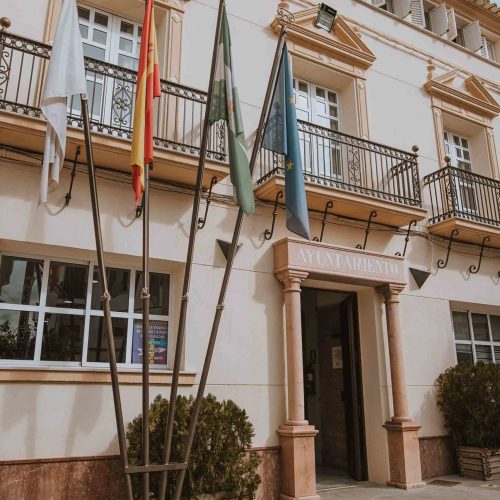
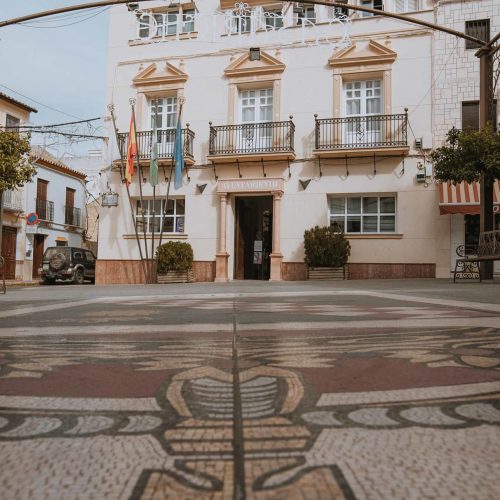
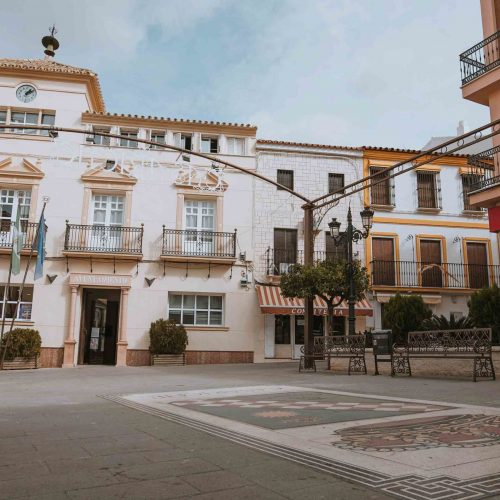
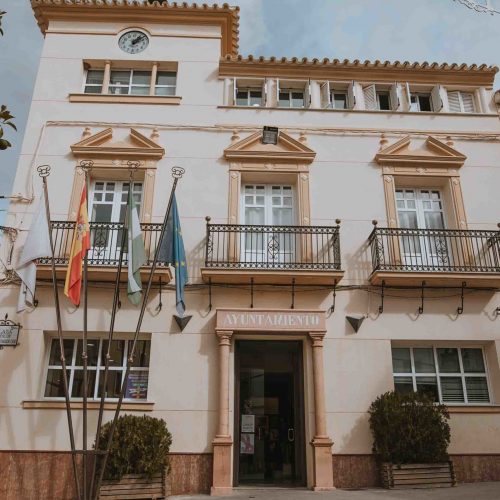
Since its beginnings, the town center of Casariche has been divided in two by the river Yeguas. Today, the area to the east constitutes the historic center of the town, with emblematic buildings as the church of Nuestra Señora de la Encarnación and the town hall. To the west, on the other hand, is the urban street that the locals identify with the Triana neighborhood, a name that has developed a strong attachment among its residents.
The most significant urban elements in this neighborhood are the Plaza de Cuba, the Triana tunnel and the bridge over the river Yeguas. The first of these, popularly known as the Plaza de Triana, has become one of the most dynamic spaces in the town, a place where the people who live in the surrounding homes come together and enjoy themselves. This space houses, attached to one of the houses, the centenary Triana fountain, consisting of a basin, a front topped by a cross and a small roof supported by iron columns; in the past, it provided water to all the inhabitants who approached it, as well as serving as a watering place for animals.
The construction of the tunnel and the Triana bridge would mark the modern development of Casariche, greatly improving the local infrastructure. On the one hand, the bridge was a guarantee when moving from one side of the town to the other, allowing a greater flow of pedestrians and road traffic between the two areas. Finally, the establishment of a railway station in Casariche, as well as the tracks that gave access to it, made it necessary to build a bridge to connect the town center with the outskirts. However, the deterioration caused by the passage of time and the increase in the number of vehicles contributed to the construction of another, larger tunnel. This one is located next to the old one, which was relegated to pedestrian use, and both form a picture that commemorates the past, present and future of Casariche.
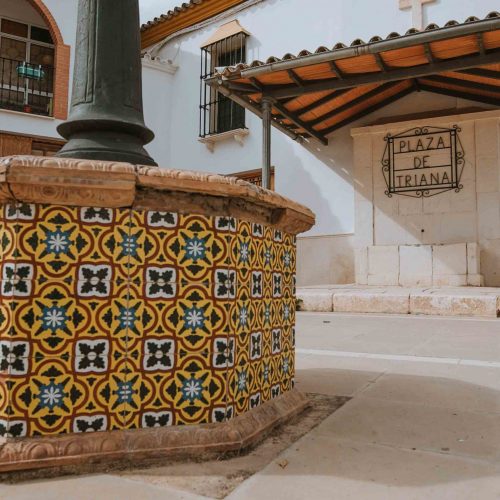
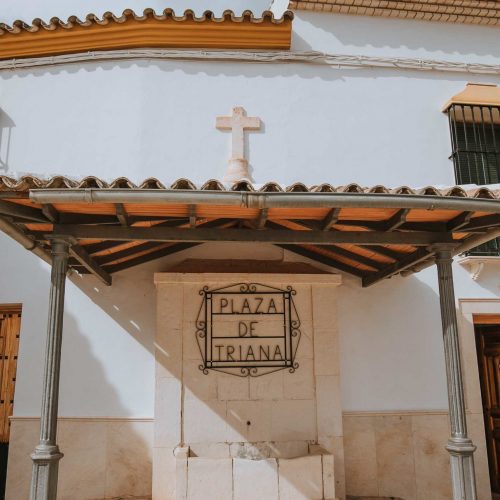
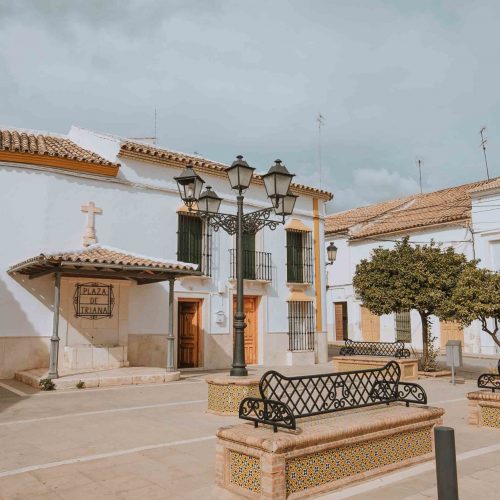
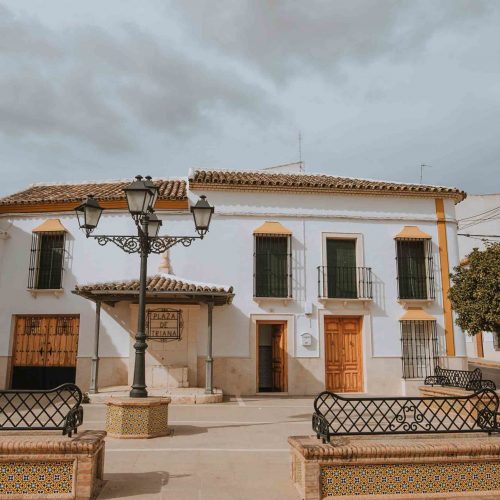
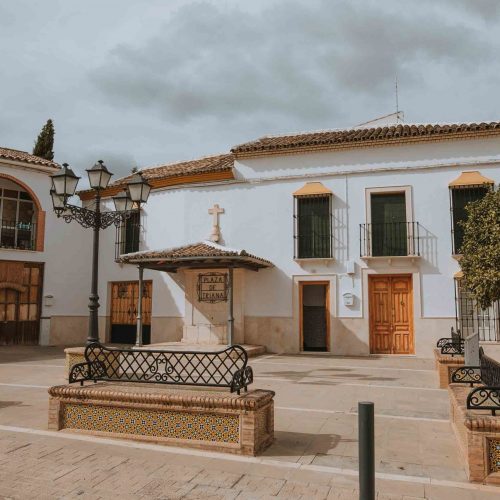
| Cookie | Tipo | Duración | Descripción |
|---|---|---|---|
| cookielawinfo-casilla-funcional | 0 | 11 meses | La cookie está configurada por GDPR Cookie Consent para registrar el consentimiento del usuario para las cookies en la categoría "Funcional". |
| cookielawinfo-casilla-necesario | 0 | 11 meses | Esta cookie está configurada por el complemento GDPR Cookie Consent. Las cookies se utilizan para almacenar el consentimiento del usuario para las cookies en la categoría "Necesario". |
| cookielawinfo-casilla-otros | 0 | 11 meses | Esta cookie está configurada por el complemento de consentimiento de cookies de GDPR. La cookie se utiliza para almacenar el consentimiento del usuario para las cookies en la categoría "Otros. |
| cookielawinfo-casilla-rendimiento | 0 | 11 meses | Esta cookie está configurada por el complemento de consentimiento de cookies de GDPR. La cookie se utiliza para almacenar el consentimiento del usuario para las cookies en la categoría "Rendimiento". |
| cookielawinfo-checkbox-análisis | 0 | 11 meses | Esta cookie está configurada por el complemento de consentimiento de cookies de GDPR. La cookie se utiliza para almacenar el consentimiento del usuario para las cookies en la categoría "Análisis". |
| vista_política_cookies | 0 | 11 meses | La cookie está configurada por el complemento GDPR Cookie Consent y se utiliza para almacenar si el usuario ha dado su consentimiento o no para el uso de cookies. No almacena ningún dato personal. |
| Cookie | Tipo | Duración | Descripción |
|---|---|---|---|
| cookielawinfo-casilla-funcional | 0 | 11 meses | La cookie está configurada por GDPR Cookie Consent para registrar el consentimiento del usuario para las cookies en la categoría "Funcional". |
| cookielawinfo-casilla-necesario | 0 | 11 meses | Esta cookie está configurada por el complemento GDPR Cookie Consent. Las cookies se utilizan para almacenar el consentimiento del usuario para las cookies en la categoría "Necesario". |
| cookielawinfo-casilla-otros | 0 | 11 meses | Esta cookie está configurada por el complemento de consentimiento de cookies de GDPR. La cookie se utiliza para almacenar el consentimiento del usuario para las cookies en la categoría "Otros. |
| cookielawinfo-casilla-rendimiento | 0 | 11 meses | Esta cookie está configurada por el complemento de consentimiento de cookies de GDPR. La cookie se utiliza para almacenar el consentimiento del usuario para las cookies en la categoría "Rendimiento". |
| cookielawinfo-checkbox-análisis | 0 | 11 meses | Esta cookie está configurada por el complemento de consentimiento de cookies de GDPR. La cookie se utiliza para almacenar el consentimiento del usuario para las cookies en la categoría "Análisis". |
| vista_política_cookies | 0 | 11 meses | La cookie está configurada por el complemento GDPR Cookie Consent y se utiliza para almacenar si el usuario ha dado su consentimiento o no para el uso de cookies. No almacena ningún dato personal. |
| Cookie | Tipo | Duración | Descripción |
|---|---|---|---|
| cookielawinfo-casilla-funcional | 0 | 11 meses | La cookie está configurada por GDPR Cookie Consent para registrar el consentimiento del usuario para las cookies en la categoría "Funcional". |
| cookielawinfo-casilla-necesario | 0 | 11 meses | Esta cookie está configurada por el complemento GDPR Cookie Consent. Las cookies se utilizan para almacenar el consentimiento del usuario para las cookies en la categoría "Necesario". |
| cookielawinfo-casilla-otros | 0 | 11 meses | Esta cookie está configurada por el complemento de consentimiento de cookies de GDPR. La cookie se utiliza para almacenar el consentimiento del usuario para las cookies en la categoría "Otros. |
| cookielawinfo-casilla-rendimiento | 0 | 11 meses | Esta cookie está configurada por el complemento de consentimiento de cookies de GDPR. La cookie se utiliza para almacenar el consentimiento del usuario para las cookies en la categoría "Rendimiento". |
| cookielawinfo-checkbox-análisis | 0 | 11 meses | Esta cookie está configurada por el complemento de consentimiento de cookies de GDPR. La cookie se utiliza para almacenar el consentimiento del usuario para las cookies en la categoría "Análisis". |
| vista_política_cookies | 0 | 11 meses | La cookie está configurada por el complemento GDPR Cookie Consent y se utiliza para almacenar si el usuario ha dado su consentimiento o no para el uso de cookies. No almacena ningún dato personal. |
| Cookie | Tipo | Duración | Descripción |
|---|---|---|---|
| cookielawinfo-casilla-funcional | 0 | 11 meses | La cookie está configurada por GDPR Cookie Consent para registrar el consentimiento del usuario para las cookies en la categoría "Funcional". |
| cookielawinfo-casilla-necesario | 0 | 11 meses | Esta cookie está configurada por el complemento GDPR Cookie Consent. Las cookies se utilizan para almacenar el consentimiento del usuario para las cookies en la categoría "Necesario". |
| cookielawinfo-casilla-otros | 0 | 11 meses | Esta cookie está configurada por el complemento de consentimiento de cookies de GDPR. La cookie se utiliza para almacenar el consentimiento del usuario para las cookies en la categoría "Otros. |
| cookielawinfo-casilla-rendimiento | 0 | 11 meses | Esta cookie está configurada por el complemento de consentimiento de cookies de GDPR. La cookie se utiliza para almacenar el consentimiento del usuario para las cookies en la categoría "Rendimiento". |
| cookielawinfo-checkbox-análisis | 0 | 11 meses | Esta cookie está configurada por el complemento de consentimiento de cookies de GDPR. La cookie se utiliza para almacenar el consentimiento del usuario para las cookies en la categoría "Análisis". |
| vista_política_cookies | 0 | 11 meses | La cookie está configurada por el complemento GDPR Cookie Consent y se utiliza para almacenar si el usuario ha dado su consentimiento o no para el uso de cookies. No almacena ningún dato personal. |
| Cookie | Tipo | Duración | Descripción |
|---|---|---|---|
| cookielawinfo-casilla-funcional | 0 | 11 meses | La cookie está configurada por GDPR Cookie Consent para registrar el consentimiento del usuario para las cookies en la categoría "Funcional". |
| cookielawinfo-casilla-necesario | 0 | 11 meses | Esta cookie está configurada por el complemento GDPR Cookie Consent. Las cookies se utilizan para almacenar el consentimiento del usuario para las cookies en la categoría "Necesario". |
| cookielawinfo-casilla-otros | 0 | 11 meses | Esta cookie está configurada por el complemento de consentimiento de cookies de GDPR. La cookie se utiliza para almacenar el consentimiento del usuario para las cookies en la categoría "Otros. |
| cookielawinfo-casilla-rendimiento | 0 | 11 meses | Esta cookie está configurada por el complemento de consentimiento de cookies de GDPR. La cookie se utiliza para almacenar el consentimiento del usuario para las cookies en la categoría "Rendimiento". |
| cookielawinfo-checkbox-análisis | 0 | 11 meses | Esta cookie está configurada por el complemento de consentimiento de cookies de GDPR. La cookie se utiliza para almacenar el consentimiento del usuario para las cookies en la categoría "Análisis". |
| vista_política_cookies | 0 | 11 meses | La cookie está configurada por el complemento GDPR Cookie Consent y se utiliza para almacenar si el usuario ha dado su consentimiento o no para el uso de cookies. No almacena ningún dato personal. |
| Cookie | Tipo | Duración | Descripción |
|---|---|---|---|
| cookielawinfo-casilla-funcional | 0 | 11 meses | La cookie está configurada por GDPR Cookie Consent para registrar el consentimiento del usuario para las cookies en la categoría "Funcional". |
| cookielawinfo-casilla-necesario | 0 | 11 meses | Esta cookie está configurada por el complemento GDPR Cookie Consent. Las cookies se utilizan para almacenar el consentimiento del usuario para las cookies en la categoría "Necesario". |
| cookielawinfo-casilla-otros | 0 | 11 meses | Esta cookie está configurada por el complemento de consentimiento de cookies de GDPR. La cookie se utiliza para almacenar el consentimiento del usuario para las cookies en la categoría "Otros. |
| cookielawinfo-casilla-rendimiento | 0 | 11 meses | Esta cookie está configurada por el complemento de consentimiento de cookies de GDPR. La cookie se utiliza para almacenar el consentimiento del usuario para las cookies en la categoría "Rendimiento". |
| cookielawinfo-checkbox-análisis | 0 | 11 meses | Esta cookie está configurada por el complemento de consentimiento de cookies de GDPR. La cookie se utiliza para almacenar el consentimiento del usuario para las cookies en la categoría "Análisis". |
| vista_política_cookies | 0 | 11 meses | La cookie está configurada por el complemento GDPR Cookie Consent y se utiliza para almacenar si el usuario ha dado su consentimiento o no para el uso de cookies. No almacena ningún dato personal. |